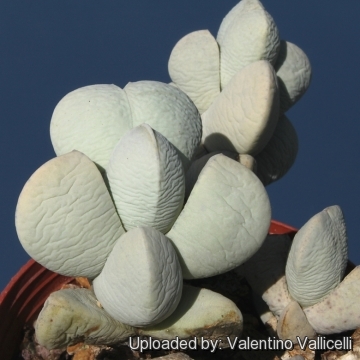= Namibia ponderosa (Dinter) Dinter & Schwantes ex H.Jacobsen
Succ. Pl. 222 (1935). H.Jacobsen
Accepted Scientific Name: Namibia cinerea (Marloth) Dinter & Schwantes
Z. Sukkulentenk. ii. 184 (1926), in obs.

Juttadinteria longipetala (Namibia ponderosa) Photo by: Valentino Vallicelli
Origin and Habitat: Southern Namib Desert (South-west Africa)
Synonyms:
See all synonyms of Namibia cinerea
back
Accepted name in llifle Database:Namibia cinerea (Marloth) Dinter & SchwantesZ. Sukkulentenk. ii. 184 (1926), in obs.Synonymy: 6
back
Description: Namibia ponderosaSN|18162]]SN|18162]] is a perennial cushion-forming succulent with very thick soft leaves. Cushions up to 20 cm broad and 10 cm high.
Leaves: Rounded to boat-shaped, up to 3 cm long and 1,4-2 cm broad and thick, very fat, soft, whitish, blue-grey or greyish green with distinct dark dots, surfaces covered with small, hair-like papillae. Keels sharp, covered with more or less distinct dots which stand in definite rows on the edges and keel.
Flowers: 3-5 cm in diameter. Petals bright pink.
Bibliography: Major references and further lectures
1) Heidrun E. K. Hartmann “Aizoaceae F – Z” Springer, 2002
2) James Cullen, Sabina G. Knees, H. Suzanne Cubey “The European Garden Flora Flowering Plants: A Manual for the Identification of Plants Cultivated in Europe, Both Out-of-Doors and Under Glass - Casuarinaceae to Aristolochiaceae” Cambridge University Press, 11/ago/2011
3) Hermann Jacobsen, Vera Higgins “Succulent Plants: Description, Cultivation and Uses of Succulent Plants, Other Than Cacti” Williams and Norgate, Limited, 1935
4) Jacobsen. “Handbook of succulent plants” 1328 (1960)
5) Herre, H., "The Genera of the Mesembryanthemaceae", vol. 10 (1973)
6) L.Bolus · S. African Gard. 17: 281. 1927
 Juttadinteria longipetala (Namibia ponderosa) Photo by: Valentino Vallicelli
Juttadinteria longipetala (Namibia ponderosa) Photo by: Valentino Vallicelli Juttadinteria longipetala (Namibia ponderosa) Photo by: Valentino Vallicelli
Juttadinteria longipetala (Namibia ponderosa) Photo by: Valentino VallicelliCultivation and Propagation: Namibia ponderosaSN|18162]]SN|18162]] is has no clear dormancy and is most active in spring and autumn, but in favourable growing conditions it keeps going over the winter too and doesn't need particular care. Namibia ponderosaSN|18162]]SN|18162]] seems to prefer a fairly dry rest in winter but grows whenever watered. In very dry warm regions these succulents make very impressive out door ground covers.
Growing rate: It is vigorous and quick-growing, speedily forming lateral shoots and low mats.
Soil: Requires good drainage as it it is prone to root rot. It can grows outdoor in sunny, dry, rock crevices (protection against winter wet is required) It can also be cultivated in alpine house, in poor, drained soil.
Fertilization: Feed it once during the growing season with a fertilizer specifically formulated for cactus succulents (poor in nitrogen), including all micro nutrients and trace elements diluted to ½ the strength recommended on the label. It thrives in poor soils and need a limited supplies of fertilizer to avoid the plants developing excess vegetation, which is easily attacked by fungal diseases.
Watering: They are not at all delicate and can take some water year-round. Water minimally in winter and summer, only when the plant starts shrivelling, water more abundantly when they are growing in the spring and autumn, but let the soil dry between soaking. An occasional summer soaking is wise. If grown in a container, bottom watering by immersing the container is recommended. It must have very dry atmosphere.
Light: It needs a bright sunny or light shade exposure in winter, but keep cool and partially shaded in summer.
Hardiness: It prefer a very bright situation and require a minimum temperature 5°C, but can be cool to cold and dry in the dead of winter. The earlier in the year they are planted, the better the chances for winter survival. True with many of the Mesembryanthemaceae.
Uses: It is an excellent plant for container growing. It always looks good and stays small. It look fine in a cold greenhouse and frame or outdoor in a rockery.
Pests & diseases: Namibia ponderosaSN|18162]]SN|18162]] may be attractive to a variety of insects, but plants in good condition should be nearly pest-free, particularly if they are grown in a mineral potting-mix, with good exposure and ventilation. Nonetheless, there are several pests to watch for:
- Red spiders: they may be effectively rubbed up by misting the vulnerable plants every day.
- Mealy bugs: occasianlly they develop aerial into the new leaves and flowers with disfiguring results, but the worst types develop underground on the roots and are invisible except by their effects.
- Sciara Flies: they are one of the major problems for seedlings. It is a good practice to mulch your seedlings with a layer of grit, which will strongly discourage the flies.
- Scales, thrips and aphids: they are rarely a problem.
It is wise to treat your whole collection with a systemic insecticide twice a year in spring and autumn.
- Rot: it is only a minor problem with mesembs if the plants are watered and “aired” correctly. If they are not, fungicides won't help all that much.
Propagation: It is very quick and easy to start from seed or cuttings. Seeds germinate in 7-14 days at 21°C in spring. To make a cutting twist off a branch with at least a part of roots and permit it to dry out a couple of days, lay it on the soil and insert the stem end partially into the soil. Try to keep the cutting somewhat upright so that the roots are able to grow downward.












